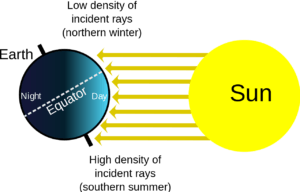It might be tempting to think that the seasons are caused by the Earth’s changing distance from the sun: that in summertime, the air feels warmer because we’re closer to the sun, and that the coldness of winter is because we are farther from the sun’s toasty rays. This seems to make sense at first, but it turns out to be a common misconception. It is true that the Earth’s orbit is slightly elliptical – that is, it doesn’t go around the sun in a perfect circle. If you’re from Canada, it might surprise you to find out that the Earth is closest to the sun (a point called “perihelion”) in January and farthest from the sun (“aphelion”) in July!
That brings us to the second part of your question, which provides an important clue about why the distance from the sun is not the reason for the seasons. Canada’s winter months, December through March, are Australia’s warmest ones. If the seasons were caused by the Earth being closer to the sun in the summer, you would expect both hemispheres to share the same seasons.
The key to understanding the seasons lies with one peculiar fact about the way the Earth orbits the sun: the axis that the Earth spins about (one turn equals one day) is actually tilted slightly – about 23.5 degrees. So the north and south poles don’t point quite straight up and down. This means that as the Earth moves around the sun, different parts of the planet get different amounts of sunlight.
Earth's tilt produces our seasons.[/caption]
When the northern hemisphere is tilted toward the sun, it has longer days and receives a higher concentration of the sun’s rays, which warms that part of the planet more than the southern hemisphere, which is tilted away, giving it shorter days and a lower intensity of sunlight. This is, as you might guess, summer in the northern hemisphere and winter in the southern hemisphere.
In between these extremes, there are points where the Earth is tilted neither toward nor away from the sun, and both hemispheres receive roughly equal amounts of sunlight and have equally long days and nights, giving us spring and autumn.
Now that you know that the tilt of the Earth causes the seasons, you might be wondering why the Earth is tilted at all. Well, we don’t really know. Some theories suggest that a giant impact while Earth was still forming could have knocked the axis off-kilter.
What we do know is that the Earth’s tilt varies with time. Over a cycle that lasts about 40,000 years, the tilt varies between 22.1 and 24.5 degrees. The tilt is also affected by the movement of large air masses or ice sheets, continental drift, and other things. When the tilt is larger, the seasons get more extreme: winters get colder and summers get hotter for both of the hemispheres. But 40,000 years is a really long time – so we won’t notice the difference in our lifetimes!
Hey kids! Have a question? Send it to [email protected].
About PI
Perimeter Institute is the world’s largest research hub devoted to theoretical physics. The independent Institute was founded in 1999 to foster breakthroughs in the fundamental understanding of our universe, from the smallest particles to the entire cosmos. Research at Perimeter is motivated by the understanding that fundamental science advances human knowledge and catalyzes innovation, and that today’s theoretical physics is tomorrow’s technology. Located in the Region of Waterloo, the not-for-profit Institute is a unique public-private endeavour, including the Governments of Ontario and Canada, that enables cutting-edge research, trains the next generation of scientific pioneers, and shares the power of physics through award-winning educational outreach and public engagement.
You might be interested in



